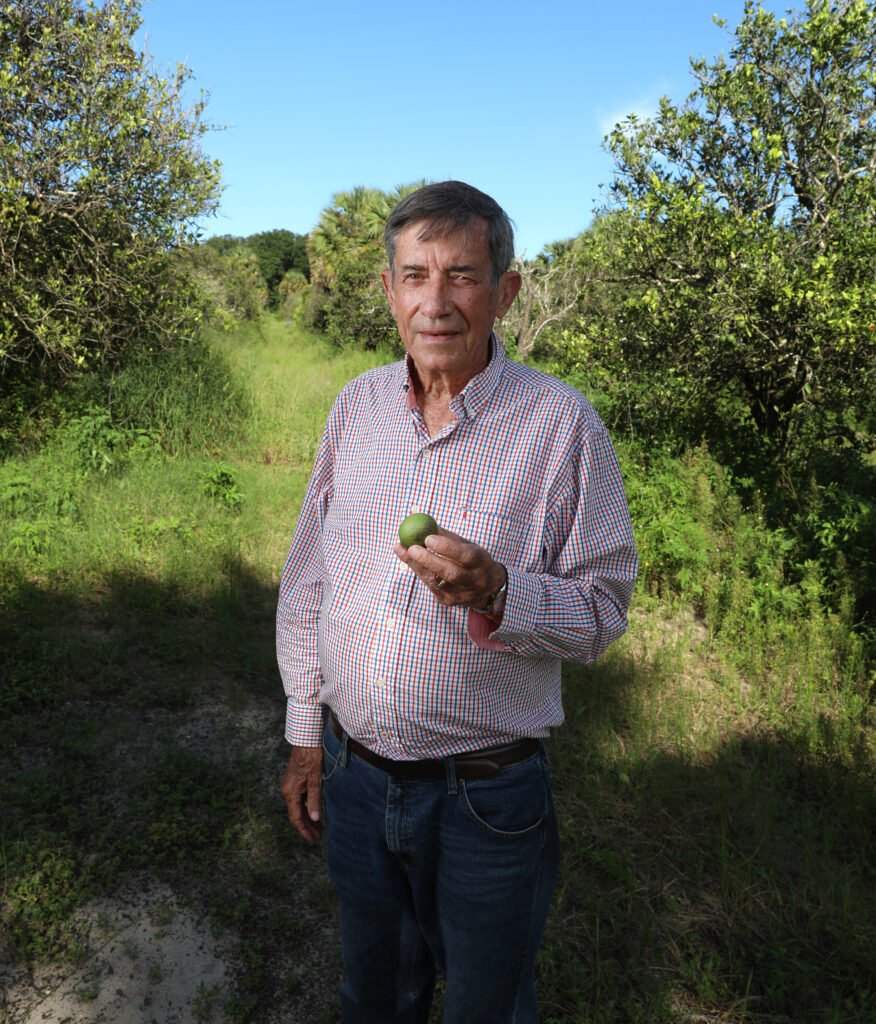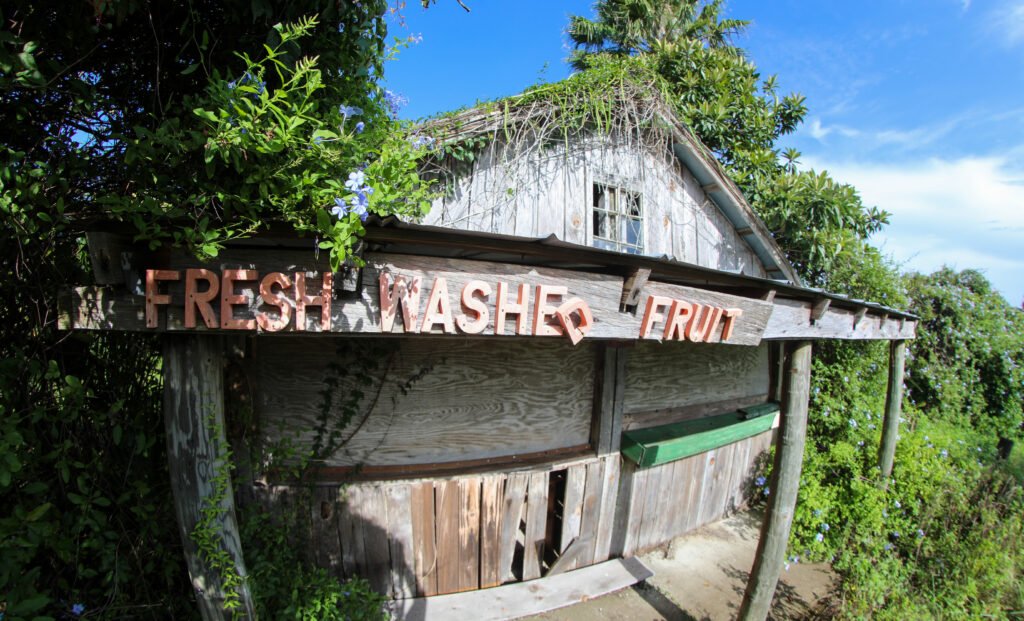
Greening is threatening Florida’s citrus industry, but cultivation of new varieties may come to the rescue
Like an ancient soldier’s widow scouring through the charred aftermath of an inglorious battlefield, quixotically searching for any scant signs of life, Bill Phillips meanders through his once-thriving orange grove just beyond the east shore of Lake Weir. He assesses the carnage of his field, the translucent state of the fruit trees that in past years filled its spatial canvas and yielded the types of harvests that earned Florida’s reputation as the nation’s orange juice factory.
Texas has its oil, Michigan its automobiles and Florida its citrus. More than beaches and Mickey Mouse, citrus for the past 170 years has been the economic engine and the iconic feature of Florida’s landscape, yet today the splendor of what was seems to be fading at the hands of a tiny insect, the vector of a bacteria causing what experts in the field call “citrus greening.”
Upon his retirement as Marion County Extension agent, Phillips began selling oranges from his fruit stand in Weirsdale back in 1996, and up to about three years ago the venture flourished – that is when greening overcame his grove and rendered the fruit unsellable.
“It’s sad to see what it has become,” said Phillips, who majored in citrus production and fruit crops at the University of Florida and also earned his master’s degree there before a 30-year career with the county. “By the time I retired, the groves were just starting to produce, and after six or seven years the groves got big enough that I began to sell wholesale.”
With the fruit stand now hiding in overgrowth, Phillips has ceased his citrus operation — attempts at rehabilitation or starting over from scratch just too costly, too time-consuming and, ultimately, too risky. Unfortunately, Phillips is not alone and groves all over the state that once showcased lush green canopies now resemble fields of kindling and have likely seen their last days producing fruit.
In the year 2000, the state of Florida produced 298 million boxes of fruit, but in 2019 that number fell to just 73 million. In Marion County, when during Phillips’ tenure with the Extension office over 13,000 acres existed for citrus production, that number has dwindled to less than 1,000 today.
Phillips’ situation is a microcosm of the problems facing the Florida citrus industry, the small-scale growers in particular. The costs of fighting this latest disease, the potential time constraints and the uncertain future make remaining in the citrus business an unlikely option when land is in high demand for development. This leaves the mighty Florida citrus industry in peril to a greater extent than it ever was in multiple freezes or in fighting the dreaded citrus canker disease that for decades has wreaked havoc on production.
“I think it’s the worst one of the challenges we have had,” said Ken MacKay, who operates a 60-acre grove in Weirsdale that was nearly 800 acres back in the 1970s. “I don’t know that it’s industry-ending and I am cautiously optimistic.”
Trees succumb to the disease through the transmission of a bacteria carried by the Asian citrus psyllid, a tiny insect first discovered in Florida in 1998. When the psyllid sucks on trees infected with a microbe called CandidatusLiberibacter asiaticus (CLas), it then spreads it to other trees. The bacterium infects the trees so that it develops yellow leaves and shoots, thinning canopies and fruit that remains mainly green and inedible. Eventually the tree dies after several years. Because of the yellowing of leaves and shoots, the Chinese officially named the disease huanglongbing (translated to “yellow shoot disease”), but it is referred to in the United States as either HLB or citrus greening.
Although citrus greening has been a global issue since 1905, it did not reach Florida until the early 2000s and did not spread widely through the state until about 2012. Having started in the southern part of the state, Marion County has only recently suffered the effects of this disease. Texas and Arizona crops also suffer from the disease and California growers have been subjected to thousands of square miles of quarantine zones in an attempt to stave off its spread.
While dire outlooks remain from many grove owners in Florida, optimism still abounds among some, including those working on potential solutions at the University of Florida Institute of Food and Agricultural Science.

“It’s going to come back,” said Pete Spykes, owner of The Orange Shop in Citra as well as groves in the south part of Florida. “The money’s still good – it’s just a question of figuring out how to grow good fruit. People are willing to pay us good money for good fruit and what we have to do is figure out how to deliver good fruit at a profit.”
Count Spykes and MacKay among those growers investing the money and effort in farming practices recommended by researchers at IFAS. Irrigation and fertilization techniques have been drastically tweaked so that trees can at the very least survive and produce some fruit until long-term solutions are reached. Through their investments, Spykes’ and Mackay’s groves show a bit more lush canopies and quality fruit though only shadows of their former glory.
MacKay’s grove produces only about a third of what it did per acre back in its heyday and at twice the production costs, but that beats operating a dead grove yielding nothing. The hope is that citrus varieties more tolerant to the disease will be coming soon and production will return closer to normal.
“What changed during this period is you had to make the decision that there were going to be years that you lost money,” MacKay said. “Those growers who have been committed to a program of fertilization and spraying, those are the ones where you still see the dark canopies and the fruit still being produced. The ones where you see an entire block just die out, usually what happens there is people said, ‘hey, there’s no sure-bet payoff at the end of the day and I don’t know that I want to spend 50 or 100 thousand dollars on production practices that I’m not going to get a payoff on later.”
The latest best practices in dealing with citrus greening include irrigating more often but at lower increments – the same holds true for fertilizing. With infected root systems not as expansive as before, the former practice of saturating the ground with hours upon hours of irrigation has turned to small amounts of watering but with greater frequency.
Spraying of insecticides to control the psyllids serves to buy growers some time, but ultimately the solution to the problem looks to be in the cultivation of tolerant varieties.
According to Micheal Rogers, a researcher with IFAS, this “spoon feeding” of water and nutrients to the trees is so far paying some dividends.
“In Florida, all the groves have citrus greening,” Rogers said. “If we can’t keep these trees productive and growing fruit then everybody goes out of business pretty quickly.
“We’re seeing that over a couple years of doing the right management, you can take a tree that’s declining in health and turn it around. We’re seeing improvements both in fruit yield and in fruit quality.”
Rogers admits that despite these small gains, which include dramatically increased production costs, the industry is nowhere near its strength of 20 years ago. That’s okay for now while growers wait for long-term solutions to come down the pike – solutions that include new varieties of citrus more tolerant to the disease.
Varieties have been discovered that hold up better against the disease than many of the commercial varieties and those are being included in breeding programs. Among them is a fresh fruit variety called Sugar Belle, which gets the disease but continues to produce quality fruit.
“The tree is very vigorous and seems to grow very fast,” Rogers said of the Sugar Belle variety. “As it is getting the disease it seems to outgrow the disease – it doesn’t drop fruit very much and the fruit can maintain very good quality. The underlying reasons for that, I don’t think we can quite say yet.”
The cultivation of tolerant fresh fruit varieties is cause for optimism and even excitement for growers, but in Florida it’s juice varieties that drive the industry bus. Historically, over 90 percent of oranges grown in the state have been of the juice variety with product going into cartons of Tropicana, Minute Maid and many others. But up to now, the greatest success in cultivating tolerant varieties of oranges have come mainly in fresh fruit.
New juice varieties are in the works, but according to Rogers, “it’s going to take a little bit longer to have them available for growers.”
Rogers points to a new juice variety that shows a lot of promise called OLL-20, a late-season Valencia orange variety identified by collaborators at Tropicana. The OLL-20 variety has been seen to grow well despite citrus greening and has produced quality fruit.
Tests on OLL-20 have shown it to be a superior piece of fruit that is only now getting into the hands of growers. In several years it is expected that OLL-20 will take over as the late-season variety in the juice industry.
As for early season varieties, the popular Hamlin has dominated the juice industry, but it has been hit especially hard by citrus greening. Researchers at IFAS in collaboration with growers are working on varieties to replace the Hamlin as an early-season variety and keep the constant supply of juice for processing plants.
“Early season is the biggest issue,” according to Rogers. “We’re hiring some new breeders to work on this problem, and we’ll eventually get there; we’ll have these varieties one day that growers will be growing to deal with the disease, but right now we just have to have people holding on.
“It’s a tough time, a real challenge for our growers.”
For those growers with the time and resources to stick it out, they will no doubt be part of an industry that takes on a different shape than before. According to Rogers, the future for the Florida citrus industry may entail a greater role in the fresh fruit varieties, something that has historically been left to California growers while Florida produces the juice varieties.
“We’re not going to come out of this the same industry as we were before citrus greening,” Rogers said. “We’re going to be a smaller industry down the road, but we’re still going to be the predominant juice industry – Florida and Brazil will retain their status as the major producers of orange juice.
“Citrus will remain the iconic crop of Florida, but we will look different.”
Rogers notes that new varieties of fresh fruit are in the experimental stages that “taste way better than anything you get out of California.” He says great tasting new fresh fruit varieties are coming out that will allow Florida to compete with the famous Cuties and Halos of California. The idea is that having a greater percentage of fresh fruit varieties will allow growers to diversify their operations, thereby hedging their losses in times of orange juice price crunches.
According to Spykes, the problem with oranges is bad enough, but grapefruit presents another set of issues.
“Grapefruit is a problem child,” Spykes said. “You can breed your way out of the orange and the mandarin problem, but you can’t breed your way out of grapefruit because you can’t cross a grapefruit with anything and still get a grapefruit.”
The key to grapefruit is identifying more tolerant varieties, one of which Spykes believes to be the Star Ruby. Even so, with experiments and trials taking place, Spykes said he expects within four or five years to have the answers to the greening situation.
“We’re not there yet, we’re in the middle, in an awkward stage where the existing susceptible trees are still declining and we haven’t really ramped up planting the new ones.”
These are optimistic outlooks and the industry is still struggling, meaning a lot of growers like Phillips are facing the pressure of holding on with the hope of future returns or eschewing the exorbitant costs and time preferences for an easier conversion of their lands. Many are choosing the latter.
For MacKay, son of former U.S. representative and governor of Florida Buddy MacKay, maintaining his grove and adapting to the changes is about more than just delayed profits, it’s about carrying the legacy of a family farm now in its third generation.
“If I were looking at it purely as a business enterprise, I’m not sure (my groves) wouldn’t already be converted to pastureland and have cows on it,” MacKay said. “Because it has been in the family for multiple generations and because I grew up being involved with it, it brings a certain level of satisfaction to see it continue to operate.”
The aftermath may be the elimination of many small growers while the large operations are able to absorb the momentary high costs and small yields. Either way, the Florida citrus industry finds itself at a significant crossroads unlike anything it has experienced. With altering farming techniques, new varieties and even a shift toward more fresh fruit, adaptation is the key to survival – the only alternative being its demise.
“I think (the Florida citrus industry) sort of bottomed out,” Spykes said. “Now, as people begin to re-plant using the techniques and varieties then we’ll see that start to increase again.”
The Florida citrus industry has faced down all comers, from hard freezes to citrus canker and now its most formidable foe: citrus greening. In the end, what will save the industry is science, dogged perseverance from growers and even a little bit of good luck. Florida citrus can certainly use all three right about now.






